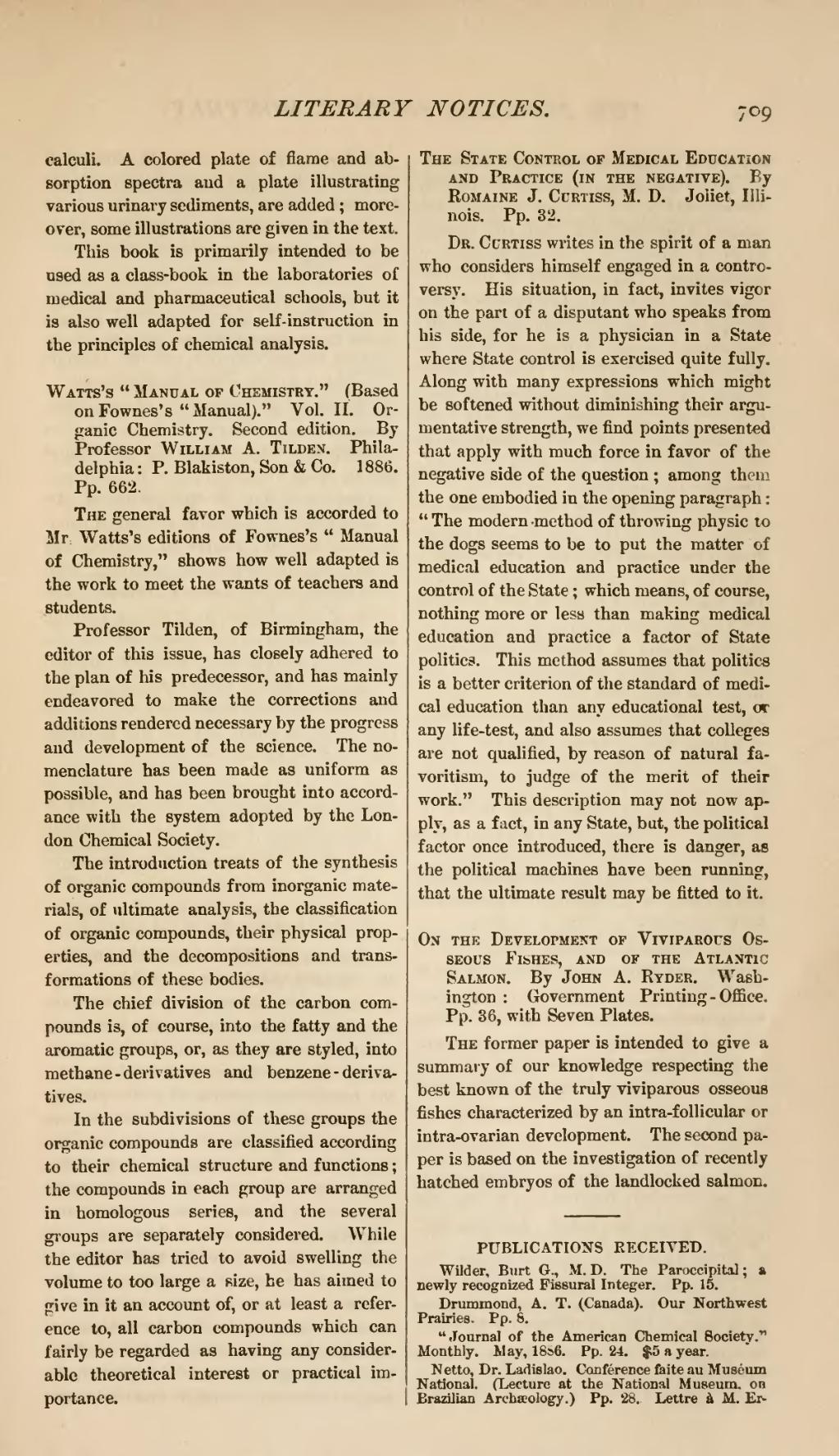calculi. A colored plate of flame and absorption spectra and a plate illustrating various urinary sediments, are added; moreover, some illustrations are given in the text. This book is primarily intended to be used as a class-book in the laboratories of medical and pharmaceutical schools, but it is also well adapted for self-instruction in the principles of chemical analysis.
Watts's "Manual of Chemistry." (Based on Fownes's "Manual)." Vol. II. Organic Chemistry. Second edition. By Professor William A. Tilden. Philadelphia: P. Blakiston, Son & Co. 1 886. Pp. 662.
The general favor which is accorded to Mr: Watts's editions of Fownes's "Manual of Chemistry," shows how well adapted is the work to meet the wants of teachers and students.
Professor Tilden, of Birmingham, the editor of this issue, has closely adhered to the plan of his predecessor, and has mainly endeavored to make the corrections and additions rendered necessary by the progress and development of the science. The nomenclature has been made as uniform as possible, and has been brought into accordance with the system adopted by the London Chemical Society.
The introduction treats of the synthesis of organic compounds from inorganic materials, of ultimate analysis, the classification of organic compounds, their physical properties, and the decompositions and transformations of these bodies.
The chief division of the carbon compounds is, of course, into the fatty and the aromatic groups, or, as they are styled, into methane-derivatives and benzene-derivatives.
In the subdivisions of these groups the organic compounds are classified according to their chemical structure and functions; the compounds in each group are arranged in homologous series, and the several groups are separately considered. While the editor has tried to avoid swelling the volume to too large a size, he has aimed to give in it an account of, or at least a reference to, all carbon compounds which can fairly be regarded as having any considerable theoretical interest or practical importance.
The State Control of Medical Education and Practice (in the negative). By Romaine J. Curtiss, M. D. Joliet, Illinois. Pp. 32.
Dr. Curtiss writes in the spirit of a man who considers himself engaged in a controversy. His situation, in fact, invites vigor on the part of a disputant who speaks from his side, for he is a physician in a State where State control is exercised quite fully. Along with many expressions which might be softened without diminishing their argumentative strength, we find points presented that apply with much force in favor of the negative side of the question; among them the one embodied in the opening paragraph: "The modern method of throwing physic to the dogs seems to be to put the matter of medical education and practice under the control of the State; which means, of course, nothing more or less than making medical education and practice a factor of State politics. This method assumes that politics is a better criterion of the standard of medical education than any educational test, or any life-test, and also assumes that colleges are not qualified, by reason of natural favoritism, to judge of the merit of their work." This description may not now apply, as a fact, in any State, but, the political factor once introduced, there is danger, as the political machines have been running, that the ultimate result may be fitted to it.
On the Development of Viviparous Osseous Fishes, and of the Atlantic Salmon. By John A. Ryder. Washington: Government Printing-Office. Pp. 36, with Seven Plates.
The former paper is intended to give a summary of our knowledge respecting the best known of the truly viviparous osseous fishes characterized by an intra-follicular or intra-ovarian development. The second paper is based on the investigation of recently hatched embryos of the landlocked salmon.
Wilder, Burt G., M. D. The Paroccipital; a newly recognized Fissural Integer. Pp. 15.
Drummond, A. T. (Canada). Our Northwest Prairies. Pp. 8.
"Journal of the American Chemical Society." Monthly. May, 186. Pp. 24. $5 a year.
Netto, Dr. Ladislao. Conférence faite au Muséum National. (Lecture at the National Museum, on Brazilian Archæology.) Pp. 28. Lettre à M. Er-

